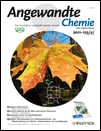Practical Conversion of Chlorosilanes into Alkoxysilanes without Generating HCl†
Ryutaro Wakabayashi
Department of Applied Chemistry, Waseda University, Ohkubo-3, Shinjuku-ku, Tokyo 169-8555 (Japan) http://www.waseda.jp/sem-kuroda_lab/
Kagami Memorial Research Institute for Materials Science and Technology, Waseda University, Nishiwaseda-2, Shinjuku-ku, Tokyo, 169-0051 (Japan)
Search for more papers by this authorYasushi Sugiura
Dow Corning Toray Co., Ltd. Chigusa-Kaigan-2, Ichihara-shi, Chiba 299-0108 (Japan)
Search for more papers by this authorDr. Toshimichi Shibue
Materials Characterization Central Laboratory, Waseda University, Ohkubo-3, Shinjuku-ku, Tokyo 169-8555 (Japan)
Search for more papers by this authorCorresponding Author
Prof. Kazuyuki Kuroda
Department of Applied Chemistry, Waseda University, Ohkubo-3, Shinjuku-ku, Tokyo 169-8555 (Japan) http://www.waseda.jp/sem-kuroda_lab/
Kagami Memorial Research Institute for Materials Science and Technology, Waseda University, Nishiwaseda-2, Shinjuku-ku, Tokyo, 169-0051 (Japan)
Department of Applied Chemistry, Waseda University, Ohkubo-3, Shinjuku-ku, Tokyo 169-8555 (Japan) http://www.waseda.jp/sem-kuroda_lab/Search for more papers by this authorRyutaro Wakabayashi
Department of Applied Chemistry, Waseda University, Ohkubo-3, Shinjuku-ku, Tokyo 169-8555 (Japan) http://www.waseda.jp/sem-kuroda_lab/
Kagami Memorial Research Institute for Materials Science and Technology, Waseda University, Nishiwaseda-2, Shinjuku-ku, Tokyo, 169-0051 (Japan)
Search for more papers by this authorYasushi Sugiura
Dow Corning Toray Co., Ltd. Chigusa-Kaigan-2, Ichihara-shi, Chiba 299-0108 (Japan)
Search for more papers by this authorDr. Toshimichi Shibue
Materials Characterization Central Laboratory, Waseda University, Ohkubo-3, Shinjuku-ku, Tokyo 169-8555 (Japan)
Search for more papers by this authorCorresponding Author
Prof. Kazuyuki Kuroda
Department of Applied Chemistry, Waseda University, Ohkubo-3, Shinjuku-ku, Tokyo 169-8555 (Japan) http://www.waseda.jp/sem-kuroda_lab/
Kagami Memorial Research Institute for Materials Science and Technology, Waseda University, Nishiwaseda-2, Shinjuku-ku, Tokyo, 169-0051 (Japan)
Department of Applied Chemistry, Waseda University, Ohkubo-3, Shinjuku-ku, Tokyo 169-8555 (Japan) http://www.waseda.jp/sem-kuroda_lab/Search for more papers by this authorThe authors are grateful to Dr. S. Sueki, Mr. K. Kawahara, Mr. H. Tachibana, and Ms. M. Tamai (Waseda University) for helpful discussions. This work was supported in part by a Grant-in-Aid for Scientific Research (No. 23245044) and the Global COE program “Practical Chemical Wisdom” from the MEXT (Japan). K.K. also acknowledges the support by Elements Science and Technology Project “Functional Designs of Silicon-Oxygen-Based Compounds by Precise Synthetic Strategies” from the MEXT (Japan).
Graphical Abstract
Alkoholfrei: Eine vielseitige und effiziente Synthese von Alkoxysilanen ohne Bildung von HCl gelingt durch die Reaktion von Chlorsilanen mit unsymmetrischen Ethern in Gegenwart einer Lewis-Säure (siehe Schema). Dieser verbesserte praktische Prozess beruht auf der selektiven Spaltung einer C-O-Bindung. Industriell einsetzbare Reagentien werden verwendet, und es entsteht nur ein einziges Koppelprodukt.
Supporting Information
Detailed facts of importance to specialist readers are published as ”Supporting Information”. Such documents are peer-reviewed, but not copy-edited or typeset. They are made available as submitted by the authors.
| Filename | Description |
|---|---|
| ange_201104948_sm_miscellaneous_information.pdf2.5 MB | miscellaneous_information |
Please note: The publisher is not responsible for the content or functionality of any supporting information supplied by the authors. Any queries (other than missing content) should be directed to the corresponding author for the article.
References
- 1C. J. Brinker, G. W. Scherer, Sol-Gel Science: The Physics and Chemistry of Sol-gel Processing, Academic Press, London, 1990.
- 2 Silanes and Other Coupling Agents, Vol. 4 (Eds.: ), Brill, Leiden, 2009.
- 3T. W. Greene, P. G. M. Wuts, Greene’s Protective Groups in Organic Synthesis, Wiley-Interscience, New Jersey, 2006.
- 4For example:
- 4aK. Tamao, K. Kobayashi, Y. Ito, Tetrahedron Lett. 1989, 30, 6051–6054;
- 4bK. Shibata, K. Miyazawa, Y. Goto, Chem. Commun. 1997, 1309–1310;
- 4cS. Shi, Y. Zhang, J. Org. Chem. 2007, 72, 5927–5930.
- 5J. V. Ebelman, Ann. Chim. 1845, 57, 319–355.
10.1002/jlac.18460570303 Google Scholar
- 6D. Seyferth, E. G. Rochow, J. Org. Chem. 1955, 20, 250–256.
- 7L. M. Shorr, J. Am. Chem. Soc. 1954, 76, 1390–1391.
- 8
- 8aR. J. P. Corriu, D. Leclercq, P. Lefèvre, P. H. Mutin, A. Vioux, J. Non-Cryst. Solids 1992, 146, 301–303;
- 8bA. Vioux, Chem. Mater. 1997, 9, 2292–2299;
- 8cL. Bourget, R. J. P. Corriu, D. Leclercq, P. H. Mutin, A. Vioux, J. Non-Cryst. Solids 1998, 242, 81–91;
- 8dJ. N. Hay, H. M. Raval, Chem. Mater. 2001, 13, 3396–3403;
- 8eL. Crouzet, D. Leclercq, P. H. Mutin, A. Vioux, Chem. Mater. 2003, 15, 1530–1534;
- 8fV. Lafond, P. H. Mutin, A. Vioux, Chem. Mater. 2004, 16, 5380–5386;
- 8gO. Lorret, V. Lafond, P. H. Mutin, A. Vioux, Chem. Mater. 2006, 18, 4707–4709;
- 8hM. Niederberger, Acc. Chem. Res. 2007, 40, 793–800;
- 8iP. H. Mutin, A. Vioux, Chem. Mater. 2009, 21, 582–596;
- 8jA. Aboulaich, O. Lorret, B. Boury, P. H. Mutin, Chem. Mater. 2009, 21, 2577–2579.
- 9R. Wakabayashi, K. Kawahara, K. Kuroda, Angew. Chem. 2010, 122, 5401–5405;
10.1002/ange.201001640 Google ScholarAngew. Chem. Int. Ed. 2010, 49, 5273–5277.
- 10M. Labrouillère, C. L. Roux, A. Oussaid, H. Gaspard-Iloughmane, J. Dubac, Bull. Soc. Chim. Fr. 1995, 132, 522–530.
- 11M. E. Jung, M. A. Lyster, J. Org. Chem. 1977, 42, 3761–3764.
- 12H. Sakurai, A. Shirahata, K. Sasaki, A. Hosomi, Synthesis 1979, 740–741.
- 13A. Kunai, T. Sakurai, E. Toyoda, M. Ishikawa, Y. Yamamoto, Organometallics 1994, 13, 3233–3236, and references therein.
- 14A. Iwata, Y. Toyoshima, T. Hayashida, T. Ochi, A. Kunai, J. Ohshita, J. Organomet. Chem. 2003, 667, 90–95, and references therein.
- 15For example:
- 15aS. Rubinsztajn, M. Zeldin, W. K. Fife, Synth. React. Inorg. Met.-Org. Chem. 1990, 20, 495–502;
- 15bK. J. Shea, D. A. Loy, O. Webster, J. Am. Chem. Soc. 1992, 114, 6700–6710;
- 15cY. Hagiwara, A. Shimojima, K. Kuroda, Chem. Mater. 2008, 20, 1147–1153.
- 16
- 16aT. Saito, Y. Nishimoto, M. Yasuda, A. Baba, J. Org. Chem. 2006, 71, 8516–8522;
- 16bJ. Yang, P. S. White, M. Brookhart, J. Am. Chem. Soc. 2008, 130, 17509–17518.
- 17J. Chojnowski, S. Rubinztajn, J. A. Cella, W. Fortuniak, M. Cypryk, J. Kujata, K. Kazmierski, Organometallics 2005, 24, 6077–6084.
- 18G. Sabitha, E. V. Reddy, R. Swapna, N. M. Reddy, J. S. Yadav, Synlett 2004, 1276–1278.
Citing Literature
This is the
German version
of Angewandte Chemie.
Note for articles published since 1962:
Do not cite this version alone.
Take me to the International Edition version with citable page numbers, DOI, and citation export.
We apologize for the inconvenience.





